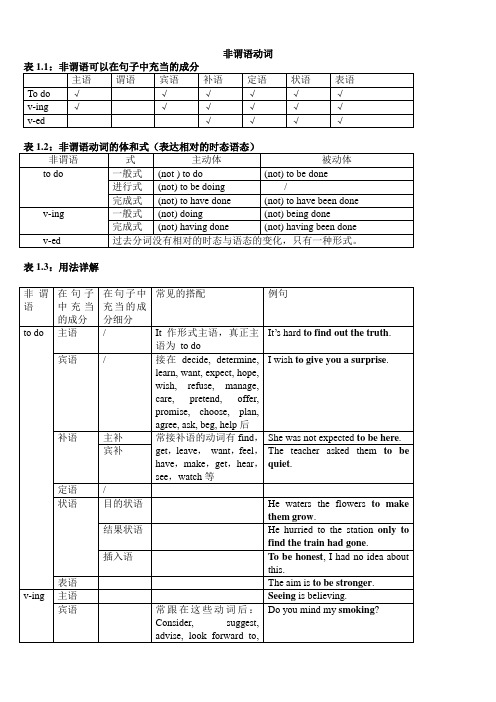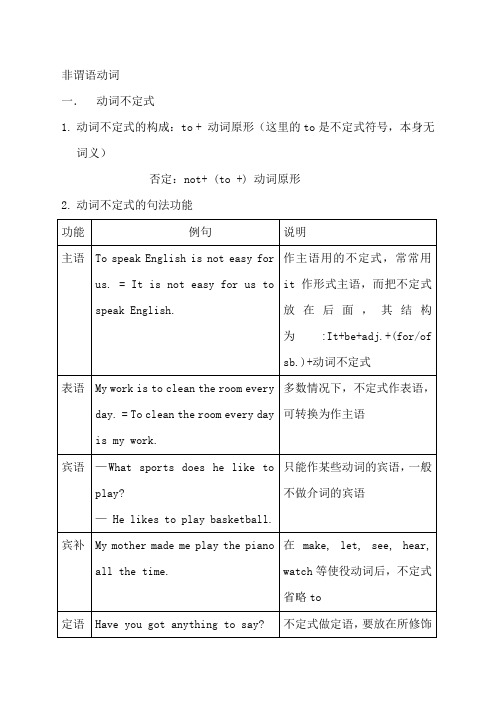2017专升本语法表格 1(动词+非谓语)
- 格式:doc
- 大小:89.00 KB
- 文档页数:9

非谓语动词知识点汇总(专升本英语)一. 常接to do的搭配(1)动词+to do:decide/determine, learn, want, expect/ hope;refuse, manage, wish, pretend; offer, promise, choose, plan;agree, ask/ beg, help等记忆口诀:决心学会想希望,拒绝设法愿假装;主动答应选计划,同意请求帮一帮。
(2)动词+sb./sth. +to do:如:want, get, wish, expect, ask, tell, order, command, beg, permit, help, advise, persuade, allow, prepare, cause, force, drive, forbid, encourage, call on, wait for, invite, teach, remind, request, prefer, train, warn等注:特殊动词常跟不带to的不定式作宾补,但变为被动语态后,不定式的to不能省略。
这类特殊动词有:记忆口诀:五看三使役:see/look/watch/notice/observe, make/let/have 二听一感半帮助:hear/listen to, feel, (to) help主动to字要离去,被动to字要回府。
(3)It形式主语① It + be + 形容词+ for/of ... + to do It be +difficult/easy/important/impossible/necessary(修饰事情)... for sb. to do sth. 某人做某事是……的It be + careless/clever/foolish/silly/stupid/kind/brave(修饰人)... of sb. to do sth.某人做某事是……的It is important for me to learn a foreign language.It is kind of you to help me.② It + be +名词词组+ to do常用名词词组:a pity, a fact, a pity, a shame, an honour, a questionIt’s a pity to leave s o early.③ It + takes (sb.)+时间(金钱)+ to do It will take a whole day to get to the top of the mountain on foot. 步行将花费一整天时间到达山顶。




非谓语动词一.动词不定式1.动词不定式的构成:to + 动词原形(这里的to是不定式符号,本身无词义)否定:not+ (to +) 动词原形2.动词不定式的句法功能1.to do 作主语常用it 作形式主语例: To learn English well is useful. → It is useful(for us)to learn English well.注意:在kind, good, nice, clever等表示人的品质的形容词后,不用for而用of.2.一些表示命令,打算或希望的动词后只接动词不定式作宾语:would like, like(想要), want, wish, hope, decide, plan, except等。
例:Would you like too see a film this evening?3.在find, think后跟动词不定式作宾语时,常用it代替,而将真正的宾语放在句末。
例:I find it easy to read English every day.4.常见的一些不带to 的动词不定式作宾语Why not do ……, why don’t you do…, had better (not) do…, would rater do…, could/ would/ will you please (not) do…例: I would rather stay in the room.5.一些使役动词和感官动词用不定式作宾语,但to要省略。
一感(fell)、二听(hear, listen to)、三让(let/ make/ let)、四看(look at, see, watch, notice)、五帮助(help),但变为被动语态是必须加上to.例:My friends were made to work the whole night by the boss.6.不定式常和疑问词what,which,when,where,how连用,相当于一个宾语从句。

非谓语动词用法简洁表格| 非谓语动词类型|构成形式|用法|例句|||||||动词不定式(to do)| to +动词原形| 1、作主语<br>To learn a foreign language is not easy (学习一门外语不容易。
)<br>2、作宾语<br>She decided to go shopping (她决定去购物。
)<br>3、作宾语补足语<br>The teacher asked us to clean the classroom (老师让我们打扫教室。
)<br>4、作定语<br>I have a lot of work to do (我有很多工作要做。
)<br>5、作状语<br>He came here to see me (他来这里看我。
)||动名词(doing)|动词原形+ ing | 1、作主语<br>Swimming is good for health (游泳对健康有益。
)<br>2、作宾语<br>He enjoys reading novels (他喜欢读小说。
)<br>3、作表语<brHis hobby is collecting stamps (他的爱好是集邮。
)<br>4、作定语<br>a swimming pool (游泳池)||现在分词(doing)|动词原形+ ing | 1、作定语<br>The sleeping baby is so cute (正在睡觉的宝宝太可爱了。
)<br>2、作状语<br>Hearing the news, she burst into tears (听到这个消息,她突然哭了起来。
)<br>3、作宾语补足语<br>I saw him playing basketball (我看见他正在打篮球。
非谓语动词表格人称代词表格称代词表格形容词性物主代词与名词性物主代词的区别一.形容词性物主代词起形容词的作用,用在名词前。
例:1. This is my book.这是我的书。
2. We love our motherland['m???l?nd] (祖国).我们热爱我们的祖国。
二.名词性物主代词起名词的作用。
例:1. Look at the two pencils. The red one is yours and the blue one is mine. 看那两支铅笔,红的是你的,蓝的是我的。
2. He likes my pen. He doesn't like hers.他喜欢我的钢笔。
不喜欢她的。
3. 注意:在使用名词性物主代词时,必须有特定的语言环境,也就是要省略的名词大家已经知道,已经提起过。
例:It's hers.是她的。
(单独使用大家不知是怎么回事,不可以这样用)There is a book. It's hers.那有本书。
是她的。
(先提及,大家才明白)4. 名词性物主代词=形容词性物主代词+名词为避免重复使用名词,有时可用“名词性物主代词”来代替“形容词性物主代词+名词”的形式。
例:My bag is yellow, her bag is red, his bag is blue and your bag is pink. 为避免重复使用bag,可写成My bag is yellow, hers is red, his is blue and yours is pink.用法:1)物主代词既有表示所属的作用又有指代作用,例如:John had cut his finger; apparently[?'p?r?ntli] (显然地)there was a broken['br?uk?n]( break的过去分词破碎的;损坏的)glass on his desk.约翰割破了手指,显而易见,他桌子上有个破玻璃杯。
1.His work is good.2.I work in Xihua University.表格3 ――5种基本句型英语五种基本句型1.Subject + Intransitive Verb (+ Adverbial)主语不及物动词(状语)2.Subject + Transitive Verb + Object主语及物动词宾语3.Subject + Transitive Verb + Object + Object Complement主语及物动词宾语宾语补足语4.Subject + Transitive Verb + Object (indirect) + Object (direct)主语及物动词宾语(间接)宾语(直接)5.Subject + Linking Verb + Subject Complement主语连系动词主语补足语/表语区分:3. 主+及物+宾+宾补VS 4. 主+及物+间宾+直宾Eg. 3. 主+及物+宾+宾补1) We call her Mary.(She is Mary.)2) I expect you to come.(You will come.)3) We saw him open the box.(He opened the box.)4) I don’t like him being rude to you.(He is being rude to you.)5) We made him happy.(He was happy.)1)We found the door locked.(The door was/had been locked.)2)We thought it foolish for you to do it.(It was foolish for you to do it.)Eg. 4. 主+及物+间宾(sb.) +直宾(sth.)1)He brought me a box of chocolate.brought a box of chocolate to/for me2)The firm promised the employees a salary increase.promised a salary increase to the employees3)English has caused me a lot of trouble.caused a lot of trouble to me4)I taught you English.taught English to you5)He told them where to go.told them where they should goHe told us a joke.told a joke to us.6)I ask you whether/if they have gone.7)I had to remind myself that being confident is not the same as being perfect!表格 4 ――情态动词+ have done “过去”1)must have done过去一定做过……(对过去发生的事情肯定的推测)“一定(已经)……”否定式只能是can’t have doneIt must have rained last night, for the ground is wet.昨晚一定下雨了,因为地面还是湿的。
非谓语动词的用法总结表格非谓语动词包括不定式,动名词和分词。
它们是高中所学的基础语法,也是高考必考内容。
既是高考的难点又是高考的热点。
真正领悟非谓语动词的用法要具备以下基础知识:①具有句子结构的知识,会分析句子成分。
②具有简单句最基本的五种句型的知识,要分得清双宾语和复合宾语。
③具有扎实而丰富的动词知识,要分得清及物动词和不及物动词。
④具备各种复合句的知识,能够拆析复合句和长难句。
●所有非谓语动词的否定形式都是把否定副词not放在非谓语动词的_前面_知识点一:非谓语作状语。
非谓语动词作状语多表示伴随状态,或事情发生的原因,结果,时间,条件等。
注意,作目的状语只能是_不定式,也可用in order to / so as to +动词原形。
解题诀窍:找逻辑主语,辩逻辑关系,析动作先后●不定式做结果状语的固定搭配only to do ,too +adj/adv to do,so +adj/adv as to do ,such +n as to do adj/ adv enough to doonly to do 常表示意想不到或不愉快的结果。
.知识点二:非谓语作定语解题诀窍:找所修饰的词,辩逻辑关系,析动作先后,面须有相应的介词。
2. 不定式用来修饰名词,表动作未发生。
3. 不定式用来修饰被序数词,最高级等限定的中心词。
知识点三:非谓语动词做补语解题技巧:记固定搭配,辩逻辑关系不定式和分词作宾语补足语(we consider him to be a nice guy)或主语补足语(He is considered to be a nice guy)是考察的重点.做题时一要熟记固定搭配,还要仔细分析非谓语所表示的动作与谓语动作发生的先后问题。
A 固定句型sb/sth be said/believed/ reported/ considered/ thought to do /to be doing /to have done 要分清.B 弄清以下搭配及其意义1.感官动词see, watch, observe, hear, listen to, notice等后面的宾补有3种形式(do/doing/done),doing表主动或正在进行,done表被动或完成,do表主动和完成(被动句中to 还原)。
1.His work is good.2.I work in Xihua University.表格3 ――5种基本句型英语五种基本句型1.Subject + Intransitive Verb (+ Adverbial)主语不及物动词(状语)2.Subject + Transitive Verb + Object主语及物动词宾语3.Subject + Transitive Verb + Object + Object Complement主语及物动词宾语宾语补足语4.Subject + Transitive Verb + Object (indirect) + Object (direct)主语及物动词宾语(间接)宾语(直接)5.Subject + Linking Verb + Subject Complement主语连系动词主语补足语/表语区分:3. 主+及物+宾+宾补VS 4. 主+及物+间宾+直宾Eg. 3. 主+及物+宾+宾补1) We call her Mary.(She is Mary.)2) I expect you to come.(You will come.)3) We saw him open the box.(He opened the box.)4) I don’t like him being rude to you.(He is being rude to you.)5) We made him happy.(He was happy.)1)We found the door locked.(The door was/had been locked.)2)We thought it foolish for you to do it.(It was foolish for you to do it.)Eg. 4. 主+及物+间宾(sb.) +直宾(sth.)1)He brought me a box of chocolate.brought a box of chocolate to/for me2)The firm promised the employees a salary increase.promised a salary increase to the employees3)English has caused me a lot of trouble.caused a lot of trouble to me4)I taught you English.taught English to you5)He told them where to go.told them where they should goHe told us a joke.told a joke to us.6)I ask you whether/if they have gone.7)I had to remind myself that being confident is not the same as being perfect!表格 4 ――情态动词+ have done “过去”1)must have done过去一定做过……(对过去发生的事情肯定的推测)“一定(已经)……”否定式只能是can’t have doneIt must have rained last night, for the ground is wet.昨晚一定下雨了,因为地面还是湿的。
Mr. Smith can't have gone to Beijing, for I saw him in the library just now.史密斯先生不可能去北京了,我刚才还在图书馆见过他。
2)may have done过去可能做过“可能(已经)……”—What has happened to George? 乔治发生了什么事?—I don't know. He may have got lost. 我不知道,他可能迷路了。
3)can have done(疑问句)本来能做……(实际没有做)“可能(已经)……”There is no light in the room. Can they have gone out?屋里没有灯,他们可能出去了吗?4)should have done ≈ought to have done过去本该做……(实际没有做)(责备语气)“本应该”shouldn’t have done过去不该做……(实际已经做过了)“本就不应该”Tom, you are too lazy. The work should have been finished yesterday.汤姆,你太懒惰了,这项工作本来应该昨天就做完的。
Look, Tom is crying. I shouldn't have been so harsh on him.看,汤姆哭了,我本来不应该对他如此严厉。
5)needn’t have done过去本来不必做……(实际已做过了)“本来不必”;need have done “本来需要……”I needn't have bought so much wine—only five people came.我本来没有必要买这么多酒,只来了五个人。
He need have hurried to the station. In that case, be wouldn't have missed the train.他本来需要快点去车站,那样的话,他就不会误了火车。
6)虚拟组would have done / could have done / might have done表格5 ――非谓语动词表格6——独立主格结构考点:独立主格中的名词或代词与其后面的动词构成逻辑上的主谓关系。
作用是在句中用作状语,可表方式,条件,因果或伴随状况。
标志: , (逗号) 即独立主格结构与主句之间不能使用任何连接词。
1)名词/主格代词I you we they he she + 现在分词,doing2)名词/主格代词+ 过去分词,done3)名词/主格代词+ 不定式,to do4)名词/主格代词+ 形容词,adj.5)名词/主格代词+ 副词,ad.6)名词/主格代词+ 介词短语,prep.7)There being + 名词(代词),8)It being + 名词(代词),Winter coming,it gets colder and colder.冬天来了,天气越来越冷了。
More time given,we should have done it much better.如果给我们更多的时间,我们会做得更好。
The boy stood there,his right hand raised.那个男生站在那里,右手高举。
Here are the first two volumes,the third one to come out next month.这是前两卷,第三卷将于下月问世。
I heard that she got injured in the accident,my heart full of worry.我听说她在这场事故中受了伤,内心充满担忧。
He stood silent in the moon-light,his door open.月光下,门开着,他默默地站立在那。
Nobody in,the thief took a lot of things away.由于没有人,小偷拿走了许多东西。
Lunch over,he left the house.午饭结束,他离开屋。
The huntsman entered the forest,gun in hand.那位猎人手里提着枪走进了树林。
He fought the wolf,a stick his only weapon.他和狼搏斗着,唯一的武器是一根棍棒。
There be 句子变成独立主格结构不能只是把be去了,而是需要把be变成being:There being no taxi, we had to walk home.There being nothing else to do, we left.由于没有其它事情可做,我们离开了。
It 句子It being Christmas, the government offices were closed. 由于圣诞节的缘故,政府机关都休息。
It being a holiday, all the shops were shut. 由于今天是假日,所有商店都关门了。
With/without 后面可以引导独立主格结构:注意with是介词,不是连词,表示一种伴随状况。
With a boy lead ing the way,they started towards the village.boy和leading之间省略was,构成独立主格。
With you to help us,we will finish the task in time.you和to之间省略了are,构成独立主格结构。
Without a word more spoken, she left the room.a word和spoken之间省略了was,构成独立主格结构。